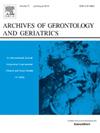高强度间歇训练与中等强度连续训练对成人动脉僵硬的影响:随机对照试验的系统回顾和荟萃分析
IF 3.5
3区 医学
Q2 GERIATRICS & GERONTOLOGY
引用次数: 0
摘要
目的动脉僵硬度(AS)被认为是心血管事件和全因死亡率的独立预测因子,并且与全球死亡率显著相关。体育活动(PA)在减少AS和改善心血管健康方面具有积极作用。本研究的目的是比较高强度间歇训练(HIIT)和中等强度连续训练(MICT)在减少AS的效果上的差异。方法对PubMed、Cochrane、Embase、Web of Science和EBSCO电子数据库进行全面检索,检索时间从这些数据库建立到2025年1月10日。我们采用固定效应模型比较HIIT组和MICT组干预前后脉搏波速度(PWV)的变化。使用加权平均差(WMD)和95%置信区间(95% CI)报告数据。结果本研究纳入22项研究的619名参与者。与MICT相比,HIIT显示出更显著的PWV降低(-0.10 m/s [95% CI:0.16至-0.03],P = 0.005)。此外,我们发现HIIT在降低CF-PWV方面具有优势(-0.10 m/s [95% CI:0.17至-0.02],P = 0.01)。结论hiit比MICT更能改善成人PWV,促进动脉健康。本文章由计算机程序翻译,如有差异,请以英文原文为准。
Effects of high-intensity interval training vs. moderate-intensity continuous training on arterial stiffness in adults: A systematic review and meta-analysis of randomized controlled trials
Objective
Arterial stiffness (AS) is regarded as an independent predictor of cardiovascular events and all-cause mortality, and it is significantly associated with global mortality rates. Physical activity (PA) plays a positive role in reducing AS and improving cardiovascular health. The aim of this study is to compare the differences between high-intensity interval training (HIIT) and moderate-intensity continuous training (MICT) in their effects on reducing AS.
Methods
We conducted a comprehensive search of the PubMed, Cochrane, Embase, Web of Science, and EBSCO electronic databases, covering the period from their inception to January 10, 2025. We used a fixed-effect model to compare the changes in pulse wave velocity (PWV) before and after intervention between the HIIT group and the MICT group. Data were reported using the weighted mean difference (WMD) and 95 % confidence interval (95 % CI).
Results
This study included 619 participants from 22 studies. Compared to MICT, HIIT demonstrated a more significant reduction in PWV (-0.10 m/s [95 % CI:0.16 to -0.03], P = 0.005). Additionally, we found that HIIT was superior in reducing CF-PWV (-0.10 m/s [95 % CI:0.17 to -0.02], P = 0.01).
Conclusion
HIIT is more effective than MICT in improving PWV and promoting arterial health in adults.
求助全文
通过发布文献求助,成功后即可免费获取论文全文。
去求助
来源期刊
CiteScore
7.30
自引率
5.00%
发文量
198
审稿时长
16 days
期刊介绍:
Archives of Gerontology and Geriatrics provides a medium for the publication of papers from the fields of experimental gerontology and clinical and social geriatrics. The principal aim of the journal is to facilitate the exchange of information between specialists in these three fields of gerontological research. Experimental papers dealing with the basic mechanisms of aging at molecular, cellular, tissue or organ levels will be published.
Clinical papers will be accepted if they provide sufficiently new information or are of fundamental importance for the knowledge of human aging. Purely descriptive clinical papers will be accepted only if the results permit further interpretation. Papers dealing with anti-aging pharmacological preparations in humans are welcome. Papers on the social aspects of geriatrics will be accepted if they are of general interest regarding the epidemiology of aging and the efficiency and working methods of the social organizations for the health care of the elderly.

 求助内容:
求助内容: 应助结果提醒方式:
应助结果提醒方式:


